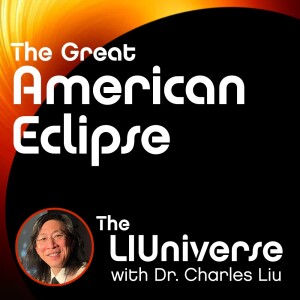
Thursday Apr 04, 2024
The Great American Eclipse
The total solar eclipse is almost here! In this special episode of The LIUniverse, Dr. Charles Liu and co-host Allen Liu bring you both the basics and some more in-depth investigations of how eclipses work, how to see them, and what makes them so unique. This episode includes clips from Chuck’s recent public talk at the College of Staten Island to a packed house. So, if you hear some background chatter, it’s the audience getting as excited about the eclipse as we are.
Today’s joyfully cool cosmic thing is, of course, the eclipse itself! Dr. Liu discusses why total solar eclipses are so rare at any given spot on the planet, and how illustrations of eclipses can miss the mark. While a total eclipse will happen somewhere on Earth every year or two, each is only visible in a narrow band, so to see one you need to get lucky – or travel.
With a path over land stretching from Mazatlán, Mexico (where Dr. Liu saw a previous eclipse in 1991) through Newfoundland, Canada, there are already tens of millions of people in place to see this astronomical wonder this time around. Millions more will travel to join them. Since the Moon’s shadow races across the landscape at about 1,000 miles per hour, Chuck likens the visual effect to something out of Lord of the Rings.
Speaking of rings, the “diamond ring effect” and the “Baily’s beads” will become visible right before totality as the sun peeks through the Moon’s valleys. Chuck and Allen talk about how to protect your eyes so to enjoy these last rays of sun safely.
Dr. Liu shares how best to get yourself into the ~100 mile wide path of totality. One piece of advice: Don’t try to battle the traffic driving up on the morning of the 8th!
What if you can’t reach totality? Charles explains that 99% of the best parts of an eclipse happen in that last 1% of the eclipse where the Sun becomes completely covered. Don’t worry if you can’t make it to the path of totality – Charles and Allen share cool stuff you can watch for including a method for calculating the true size of the Moon (link below).
Dr. Liu also explains his idea about how to have the most fun with the eclipse, and why his favorite 2017 eclipse photo isn’t a masterpiece.
If you’re a fan of the LIUniverse, you know we love questions. At Dr. Liu’s recent public talk at the College of Staten Island, he fielded live questions from the audience which we’ve included here. The first is about a comet called 12P Pons-Brooks that you can spot in the direction of the sun during the eclipse, perhaps just on the edge of visibility with your unaided eye.
The next question is about how we are able to predict eclipses so far in advance. Allen explains how the Babylonians used Lunar eclipses (or “Blood Moons”) as the key to predict Solar eclipses. Allen also adds his own calculations about where else in the solar system you can see a total eclipse – it’s often said that the Earth is the only planet where total eclipses happen, but that might only be partially correct. Also, find out where you’d need to park a spaceship to create your own eclipse whenever you want!
Our last question ponders why the Sun throws out such large and bright flares and coronal streamers which become visible as fiery red and ghostly white spikes coming from the Sun during an eclipse. The answer explains how the Sun is like a pot of boiling water, with some fun science terms thrown in for flavor! Can you say “magnetohydrodynamics” three times fast? We conclude the discussion with a little more Solar physics: how we’ve recently sent a space probe into those very same coronal streamers, and how the Sun is nearing the peak of its 11 year cycle, offering some bonus chances to test out your eclipse glasses.
The LIUniverse wants to help you have the best, safest, and most informed experience for the celestial display of the decade. We hope you enjoy this episode. Please support us on Patreon.
How to measure the Moon’s size.
Smarter Every Day’s ISS video.
Credits for Images Used in Episode
– Baily’s beads, 2017 total solar eclipse – NASA/Aubrey Gemignani, Public Domain
– Diamond ring, 2017 total solar eclipse – NASA/Aubrey Gemignani, Public Domain
– The ISS in front of 2017 eclipse – NASA/Bill Ingalls, CC BY 2.0
– Comet 12P Pons-Brooks – Nielander, Public Domain
– A Total Lunar Eclipse in January 2019 – Giuseppe Donatiello, Public domain
– Phobos in front of the Sun (from Perseverance rover) – NASA/JPL-Caltech/ASU/MSSS/SSI, Public Domain
– Jupiter and Galilean Moons (photos combined) – NASA/JPL/DLR, Public Domain
– The bubbling surface of the Sun – NSO/NSF/AURA, CC BY 4.0
– Solar Flare seen from Skylab in 1973 – NASA, Skylab 4 crew, Public Domain
– Coronal streamers seen by Parker Solar Probe – NASA, Public Domain
– The giant sunspot in Feb. 2024 – NASA SOHO space probe, Public Domain
#TheLIUniverse #CharlesLiu #AllenLiu #SciencePodcast #AstronomyPodcast #TotalSolarEclipse #GreatAmericanEclipse #eclipse #sunspot #coronalstreamer #solarflare #Sun #Comet12PPonsBrooks #Baily’sbeads #Diamondring #magnetohydrodynamics #Jupiter #GalileanMoons #Moon
No comments yet. Be the first to say something!